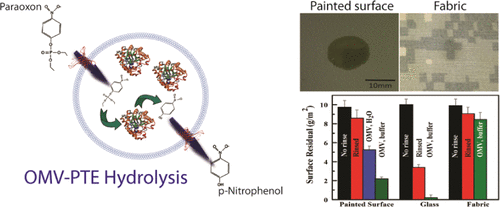当前位置:
X-MOL 学术
›
ACS Appl. Mater. Interfaces
›
论文详情
Our official English website, www.x-mol.net, welcomes your feedback! (Note: you will need to create a separate account there.)
Environmental Decontamination of a Chemical Warfare Simulant Utilizing a Membrane Vesicle-Encapsulated Phosphotriesterase
ACS Applied Materials & Interfaces ( IF 9.5 ) Pub Date : 2018-04-19 00:00:00 , DOI: 10.1021/acsami.8b02717 Nathan J. Alves 1 , Martin Moore 2 , Brandy J. Johnson 2 , Scott N. Dean 3 , Kendrick B. Turner 2 , Igor L. Medintz 2 , Scott A. Walper 2
ACS Applied Materials & Interfaces ( IF 9.5 ) Pub Date : 2018-04-19 00:00:00 , DOI: 10.1021/acsami.8b02717 Nathan J. Alves 1 , Martin Moore 2 , Brandy J. Johnson 2 , Scott N. Dean 3 , Kendrick B. Turner 2 , Igor L. Medintz 2 , Scott A. Walper 2
Affiliation

|
While technologies for the remediation of chemical contaminants continue to emerge, growing interest in green technologies has led researchers to explore natural catalytic mechanisms derived from microbial species. One such method, enzymatic degradation, offers an alternative to harsh chemical catalysts and resins. Recombinant enzymes, however, are often too labile or show limited activity when challenged with nonideal environmental conditions that may vary in salinity, pH, or other physical properties. Here, we demonstrate how phosphotriesterase encapsulated in a bacterial outer membrane vesicle can be used to degrade the organophosphate chemical warfare agent (CWA) simulant paraoxon in environmental water samples. We also carried out remediation assays on solid surfaces, including glass, painted metal, and fabric, that were selected as representative materials, which could potentially be contaminated with a CWA.
中文翻译:

使用膜囊泡封装的磷酸三酯酶对化学战模拟物的环境净化
尽管用于修复化学污染物的技术不断涌现,但人们对绿色技术的兴趣日益浓厚,促使研究人员探索源自微生物物种的天然催化机制。一种这样的方法,酶促降解,为苛刻的化学催化剂和树脂提供了一种替代方法。然而,重组酶在非理想的环境条件下挑战时通常太不稳定或显示出有限的活性,这些环境条件可能在盐度,pH或其他物理特性上有所不同。在这里,我们演示了如何封装在细菌外膜囊泡中的磷酸三酯酶可用于降解环境水样品中的有机磷酸盐化学战剂(CWA)模拟对氧磷。我们还对固体表面(包括玻璃,金属漆和织物)进行了修复分析,
更新日期:2018-04-19
中文翻译:

使用膜囊泡封装的磷酸三酯酶对化学战模拟物的环境净化
尽管用于修复化学污染物的技术不断涌现,但人们对绿色技术的兴趣日益浓厚,促使研究人员探索源自微生物物种的天然催化机制。一种这样的方法,酶促降解,为苛刻的化学催化剂和树脂提供了一种替代方法。然而,重组酶在非理想的环境条件下挑战时通常太不稳定或显示出有限的活性,这些环境条件可能在盐度,pH或其他物理特性上有所不同。在这里,我们演示了如何封装在细菌外膜囊泡中的磷酸三酯酶可用于降解环境水样品中的有机磷酸盐化学战剂(CWA)模拟对氧磷。我们还对固体表面(包括玻璃,金属漆和织物)进行了修复分析,



























 京公网安备 11010802027423号
京公网安备 11010802027423号